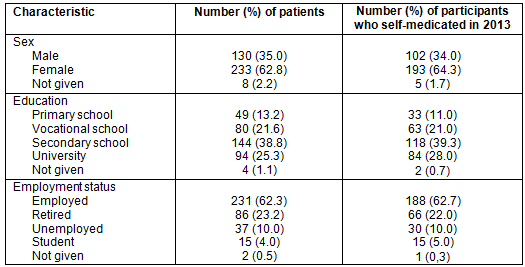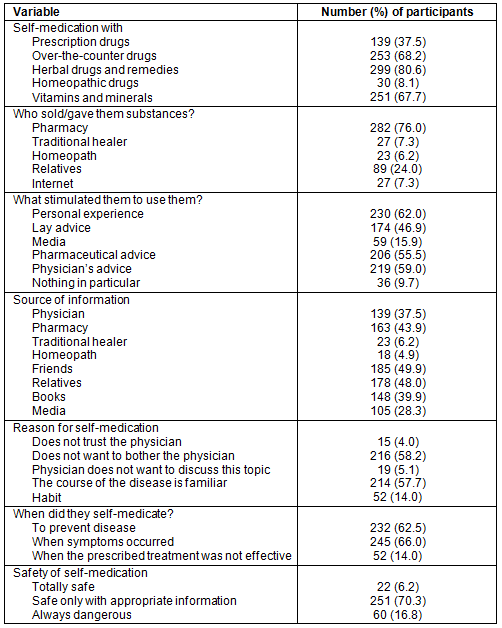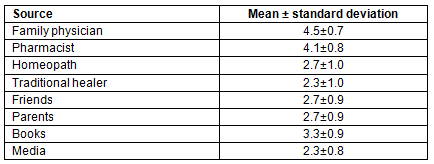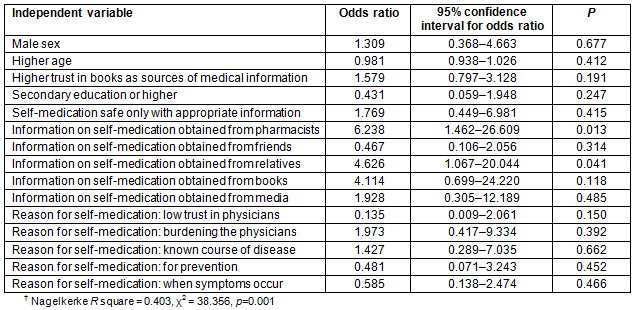Self-medication is defined as the use of medicines without medical supervision to treat one's own ailment1. Usually it is the first choice of self-treatment when faced with the symptoms of disease2, so self-medication is very common; it is estimated that around 80% of people use drugs and other substances in this way3-5. It is therefore obvious that the majority of patients in family medicine use self-medication when experiencing a deterioration in their health.
The general public's view on the safety of self-medication is that drugs and remedies for self-medication are completely safe and can be used without any precautions6. However, this can result in inappropriate use, a manifestation of serious side effects, or dangerous interactions with conventional medicines7,8.
In Slovenia, the national healthcare system is based on a combination of the Beveridge and Bismarck models; the Bismarck insurance model of financing healthcare is used, but for political reasons there is only one insurance company in Slovenia - the National Health Insurance Institute. Every resident of Slovenia is insured through their employment status, or, if unemployed, through local communities. Compulsory health insurance covers over 80% of all healthcare costs and, through the purchase of a voluntary insurance top-up payment, the remaining healthcare costs and additional services provided to the customer above the basic level can also be covered. Preparing the network of healthcare institutions is the responsibility of the state, comprising public primary healthcare centres, private family physicians and dentists, pharmacies, specialist services and public hospitals9,10.
Primary healthcare in Slovenia consists of family physicians, paediatricians, gynaecologists and dentists. Family physicians serve as partial gatekeepers, as the majority of secondary and tertiary healthcare is available only through a referral9. The drug market in Slovenia is regulated by state legislation and most drugs are available only on prescription. The medications and remedies available freely in pharmacies and specialised stores are herbal drugs, vitamins and minerals, topical anti-rheumatics, lower strength oral non-steroidal anti-inflammatory drugs, lower strength oral antihistamines, and some non-opioid analgesics (ie paracetamol)3. People in Slovenia can therefore practise self-medication with over-the-counter (OTC) drugs, which can be bought only in pharmacies, as well as different herbal remedies, which can be bought in pharmacies as well as in some specialist shops4. Some remedies and OTC drugs can also be bought on the internet11. In addition, it has been shown that people practise self-medication with prescribed drugs which were only partly used at the time of prescription and were then stored in home medicine chests12.
It is known that the place of residence significantly affects assessment of health status, healthcare utilisation and health-related behaviour13. It can therefore be expected that self-medication behaviour could also differ between urban and rural areas14.
Self-medication in rural areas has already been studied in several countries, with reports of its prevalence ranging from 20 to 80%15-19. It was found that self-medication was associated with several demographic characteristics such as female sex15, the absence of chronic diseases15, lower education14 and younger patients18. However, previous studies did not explore factors such as the reasons for self-medication and its sources in rural areas.
As previous Slovenian studies on self-medication showed that people practise it very often, and sometimes not in a safe way3,4,20,21, the authors wanted to explore these issues in rural populations as well. In this study the authors wanted to determine the prevalence of self-medication in patients attending rural and remote family physicians and detect the important factors that were associated with it.
Type of study
A cross-sectional multicentre study in rural and remote family medicine practices in Slovenia was performed. The term 'rural' in health care is difficult to define, as it differs in different countries; several other similar terms are also used, such as 'remote', 'peripheral' and 'isolated'22. In general, rural and remote practices are defined as practices outside urbanised areas, where primary health care is provided by a small number of family physicians, with limited access to specialists and advanced diagnostic equipment23. In Slovenia, there is no official definition of rural practice. However, the one most often used is a definition produced by the Section for Rural and Remote Family Physicians, which states that rural and remote family practices in Slovenia are those located in rural areas, outside the larger settlements (in places with less than 5000 inhabitants and in places that are remote from major cities by at least 15 km); or in a very rural, agricultural, mountainous or sparsely populated area; or in remote areas (>20 km to the nearest hospital and/or emergency unit)22.
The study took place from 1 May to 30 June 2014. All the participants gave informed consent for their participation in the study.
Settings
The study took place in rural and remote family medicine practices in Slovenia. According to data from the Slovenian Section for Family Physicians working in Rural and Remote Areas, there are currently 207 family medicine practices in rural and remote parts of Slovenia. From these, a stratified sample (according to Slovenian region) was drawn (N=50). These practices were contacted through email. In cases of no response, one of the researchers made personal contact by phone.
Participants
The participants were patients coming to their family physician on a particular day. The inclusion criteria were as follows: age 18 years or more, and informed consent for their participation in the study. Participation was voluntary and anonymous. The exclusion criteria were as follows: patients with dementia, psychosis, or in an emergency situation, and age less than 18 years.
Data collection
Self-medication was defined as the use of prescription drugs from home medicine chests, the use of OTC drugs available in Slovenia, the use of herbal drugs and remedies, the use of vitamins and/or minerals, and the use of homeopathic drugs. A validated questionnaire on self-medication was used, which had been used previously in Slovenian studies3,4. It consisted of questions about demographic characteristics (sex, age, education and working status), questions about health status, questions about self-medication practice, and questions about attitudes towards self-medication. The level of participants' trust in different sources of medical information was measured by a five-point Likert scale.
The participants were asked to take into account the year 2013 when completing the questionnaire.
The questionnaires were sent by post to the family physicians that had agreed to participate in the study. Each family physician was asked to distribute 30 questionnaires to consecutive patients on one practice day. The patients filled in the questionnaires themselves in the doctor's surgery and returned them to a practice nurse. The physicians then returned the questionnaires to the researchers by post.
Statistical analysis
The statistical analysis was carried out using the Statistical Package for Social Sciences v22.0 (SPSS, http://www.spss.com). The researchers performed a χ2 test and a t-test for independent samples. Also carried out was a binary logistic regression, including all the variables that were statistically significant in the bivariate analyses. A value of p<0.005 was regarded as statistically significant.
Ethics approval
The study was approved by the National Ethics Committee of the Republic of Slovenia (No. 131/02/14).
Of the 50 invited family physicians, 24 (48.0%) participated in the study, and 371 (51.5%) patients completed the questionnaires.
Sample description
There were 233 (62.8%) women in the sample (Table 1). The mean age of the participants was 48.1 (±15.1) years.
In 2013, the participants had on average of 2.0 (±0.8) health problems. Almost half of the participants, 162 (43.7%), reported having at least one chronic disease.
Self-medication practices
In 2013, self-medication was practised by 300 (80.9%) participants, of which 193 (64.3) were women (Table 1). Most of the participants reported using herbal drugs for self-medication, decided to self-medicate on the basis of their own experience, got the information on self-medication from friends, bought the substances for self-medication in drugstores, self-medicated because they did not want to bother their physician, self-medicated when experiencing health problems, and thought that self-medication was safe only with appropriate information (Table 2).
The participants' trust in their family physician as a source of medical information was the highest, followed by trust in pharmacists, and the lowest in the media and traditional healers (Table 3).
Associations between variables and self-medication
Younger participants were more likely to self-medicate (t= -2.347, p=0.019). Higher trust in books as sources of medical information was associated with more prevalent self-medication (t=2.478, p=0.014). Self-medication was also more prevalent in participants with higher education, in those who thought that self-medication was safe only with the appropriate information, those who obtained information from pharmacists, friends, relatives, books and the media, those who practised self-medication due to low trust in their physicians, those who did not want to burden their physicians, those who already knew the course of their disease, those who used self-medication for prevention, and those who used self-medication when symptoms occurred (Table 4). Other variables did not show any statistically significant differences in bivariate analyses.
In multivariate analysis, the variables independently associated with self-medication were information on self-medication obtained from pharmacists and information on self-medication obtained from relatives. Also, some other variables had high odds ratios such as information on self-medication obtained from books, information on self-medication obtained from the media and reason for self-medication: burdening the physicians (Table 5).
Table 1: Demographic characteristics of the sample

Table 2: Self-medication practices

Table 3: Levels of trust in different sources of medical information

Table 4: Associations between self-medication and some characteristics of the sample

Table 5: Multivariate analysis? for the prevalence of self-medication controlled for sex and age

Discussion
This study showed that self-medication is a very common practice in rural settings and that people mostly use herbal drugs and remedies and OTC drugs. It also showed that advice from pharmacists and lay people (ie relatives, friends) plays an important role when deciding to practice self-medication.
This is the first study in Slovenia on self-medication practice in rural patients in primary health care. A study from 2010 that studied self-medication practices in the general population showed a lower prevalence (51%) of self-medication but, similarly to the present study, reported that herbal drugs were used most4. The prevalence of self-medication found in other studies ranged from 20% to 80%15-19, which points to the fact that self-medication in Slovenian rural areas is very common even when compared to other countries. In Slovenia, there is a rich tradition of knowledge of herbal medicines, which is present mostly in rural areas and among older people24. Because of this, high self-medication practices in those areas were expected.
Most of the participants said that self-medication was safe only with appropriate information, which is also in line with other studies3,4,20. Even though this is a value judgement, because an individual's perception of safety level may differ from that of a professional, it still shows that people are aware of the possible dangers of self-medication and seek information prior to its use. This gives hope that, despite the fact that self-medication in Slovenian rural areas is very common, people use it with caution.
Almost 40% of the participants in the present study reported using prescription drugs from their home medicine chests, which is in line with the findings of another Slovenian study4. A study on home-kept prescription drugs12 showed that more than 70% of the general population kept leftover prescription drugs at home for further use at their own discretion. Based on other studies it seems that this is a worldwide problem25. Unused prescription drugs accumulated in homes may be misused for recreation, used inappropriately for self-medication of future ailments, or ingested accidentally25. On the other hand, chronic patients also keep prescription drugs for their chronic diseases in home medicine chests. Obviously, there is a need for in-depth studies on the reasons for and practices of retaining prescription drugs at home.
An important reason for practising self-medication was the statement not to burden their physician with their health problems, which was found also in other studies3,4,7. Several other studies showed that responsible self-medication (ie taking medicines that do not require prescriptions to treat symptoms) might reduce the burden on health care systems26,27. On the other hand, previous studies also showed that people thought that self-medication was completely safe28. Despite the finding that a lot of participants said that they practise self-medication when faced with self-limiting symptoms or diseases, this could present a problem. In Slovenia, there is a shortage of family physicians, especially in rural areas29, which could lead to a wish by people not to burden their physicians. Of course, this could be potentially dangerous as important medical conditions could be recognised late.
The present study also showed that the participants valued advice on self-medication from different sources, especially from pharmacists and relatives, as was also shown in the Slovenian study3. A study from Pakistan14, on the other hand, showed that people in rural areas seek advice mainly from their physicians. It seems that, in Slovenia, lay advice from relatives and friends is an important source of information. This could be potentially dangerous as lay people may not have the right information, and their advice could therefore be a potential source of health risk.
This study has several limitations. The first is the problem of the definition of rural family medicine practices in Slovenia. As there is no formal definition, and no formal list of rural practices exists, the researchers had to rely on the data in the Section for Rural and Remote Family Physicians. It is possible that their data are incomplete, so the authors might have missed some rural practices when inviting them to participate. This could therefore be a possible source of selection bias. Another limitation that could also present a potential selection bias is the fact that only half of the invited patients participated, and it is also possible that the physicians did not invite 30 patients, but fewer. As data on the non-respondents was not collected, possible differences could not be analysed. Therefore, one should be careful when generalising the results to the whole rural population of Slovenia.
People residing in the rural areas of Slovenia very commonly practise self-medication. In fact, the prevalence of self-medication in these areas is one of the highest in the world. Most people reported that self-medication was safe only with the appropriate information, but on the other hand they commonly used prescription drugs of their own volition and they frequently did not go to see their physicians when ill because they did not want to burden them. The researchers therefore conclude that self-medication in rural Slovenia is moderately safe.
Acknowledgements
This study was partially supported by an unrestricted program grant from the National Research Agency P3 0339.
References
1. Saint Arnault D. Cultural determinants of help seeking: a model for research and practice. Research and Theory of Nursing Practice 2009; 23(4): 259-278.
2. Martins AP, Miranda Ada C, Mendez Z, Soares MA, Ferreira P, Nogueira A. Self-medication in a Portuguese urban population: a prevalence study. Pharmacoepidemiology and Drug Safety 2002; 11(5): 409-414.
3. Klemenc-Ketis Z, Kersnik J. The effect of demographic characteristics on self-medication patterns: a cross-sectional nationwide study from Slovenia. Collegium Antropologicum 2011; 35(4): 1237-1242.
4. Smogavec M, Softic N, Kersnik J, Klemenc-Ketis Z. An overview of self-treatment and self-medication practices among Slovenian citizens. Zdravni?ki Vestnik 2010; 79: 757-763.
5. Blenkinsopp A, Bradley C. Over the counter drugs: patients, society and the increase in self-medication. British Medical Journal (Clinical Research Ed) 1996; 312(629-632): 629.
6. Wirtz VJ, Taxis K, Dreser A. Pharmacy customers' knowledge of side effects of purchased medicines in Mexico. Tropical Medicine and International Health 2009; 14(1): 93-100.
7. Vickers KA, Jolly KB, Greenfield SM. Herbal medicine: women's views, knowledge and interaction with doctors: a qualitative study. BMC Complementary and Alternative Medicine 2006; 6: 40.
8. Ilhan MN, Durukan E, Ilhan SO, Aksakal FN, Ozkan S, Bumin MA. Self-medication with antibiotics: questionnaire survey among primary care center attendants. Pharmacoepidemiology and Drug Safety 2009; 18(12): 1150-1157.
9. Oleszczyk M, Svab I, Seifert B, Krzto?-Królewiecka A, Windak A. Family medicine in post-communist Europe needs a boost. Exploring the position of family medicine in healthcare systems of Central and Eastern Europe and Russia. BMC Family Practice 2012; 13: 15.
10. Kersnik J. An evaluation of patient satisfaction with family practice care in Slovenia. International Journal for Quality in Health Care 2000; 12(2): 143-147.
11. Klemenc-Ketis Z, Kersnik J. Seeking health advice on the internet in patients with health problems: a cross-sectional population study in Slovenia. Informatics for Health and Social Care 2013; 38: 280-290.
12. Klemenc-Ketis Z, Kersnik J. Souces and predictors of home-kept prescription drugs. International Journal of Clinical Pharmacology and Therapeutics 2010; 48(11): 705-707.
13. Cummins S, Curtis S, Diez-Roux AV, Macintyre S. Understanding and representing 'place' in health research: a relational approach. Social Science and Medicine 2007; 65(9): 1825-1838.
14. Aqeel T, Shabbir A, Basharat H, Bukhari M, Mobin S, Shahid H, et al. Prevalence of self-medication among urban and rural population of Islamabad, Pakistan. Tropical Journal of Pharmaceutical Research 2013; 62(5): 426-429.
15. Petrovcic R. Defining rural, remote, and isolated practices: example of Slovenia. Family Medicine & Primary Care Review 2016; 18(3): 391-393.
16. Rourke J. In search of a definition of 'rural'. Canadian Journal of Rural Medicine 1999; 2(3): 113.
17. Papakosta M, Zavras D, Niakas D. Investigating factors of self-care orientation and self-medication use in a Greek rural area. Rural and Remote Health (Internet) 2014; 14: 2349. Available: www.rrh.org.au (Accessed 26 January 2016).
18. Ahmad A, Patel I, Mohanta G, Ballkrishnan R. Prevalence and pattern of self-medication practices in a rural area of Barabanki. Annals of Medical and Health Sciences Research 2014; 4(Suppl 2): S73-S78.
19. Nunes de Melo M, Madureira B, Nunes Ferreira AP, Mendez Z, Miranda Ada C, Martins AP. Prevalence of self-medication in rural areas of Portugal. Pharmacy World and Science 2006; 28(1): 19-25.
20. Shankar PR, Partha P, Shenoy N. Self-medication and non-doctor prescription practices in Pokhara valley, Western Nepal: a questionnaire-based study. BMC Family Practice 2002; 3: 17.
21. Wardle J, Lui CW, Adams J. Complementary and alternative medicine in rural communities: current research and future directions. Journal of Rural Health 2012; 28(1): 101-112.
22. Klemenc-Ketis Z, Hladnik Z, Kersnik J. Self-medication among healthcare and non-healthcare students at the University of Ljubljana, Slovenia. Medical Principles and Practice 2009; 19(5): 395-401.
23. Klemenc-Ketis Z, Hladnik Z, Kersnik J. A cross sectional study of sex differences in self-medication practices among university students in Slovenia. Collegium Antropologicum 2011; 35(2): 329-334.
24. Klemenc-Ketis Z, Verovnik F. The use of the medicinal herbs in the city of Velenje. Zdravni?ki Vestnik 2004; 73(2): 59-62.
25. Wu PE, Juurlink DN. Unused prescription drugs should not be treated like leftovers. Canadian Medical Association Journal 2014; 186(11): 815-816.
26. Aljinovic-Vucic V, Trkulja V, Lackovic Z. Content of home pharmacies and self-medication practices in households of pharmacy and medical students in Zagreb, Croatia: findings in 2001 with a reference to 1977. Croatian Medical Journal 2005; 46(1): 74-80.
27. World Health Organization. The benefits and risks of self-medication. WHO Drug Information 2000; 14: 1-2.
28. Wazaify M, Shields E, Hughes CM, McElnay JC. Societal perspectives on over-the-counter (OTC) medicines. Family Practice 2005; 22(2): 170-176.
29. Petek Ster M, Svab I, Zivcec Kalan G. Factors related to consultation time: experience in Slovenia. Scandinavian Journal of Primary Health Care 2008; 26(1): 29-34.
